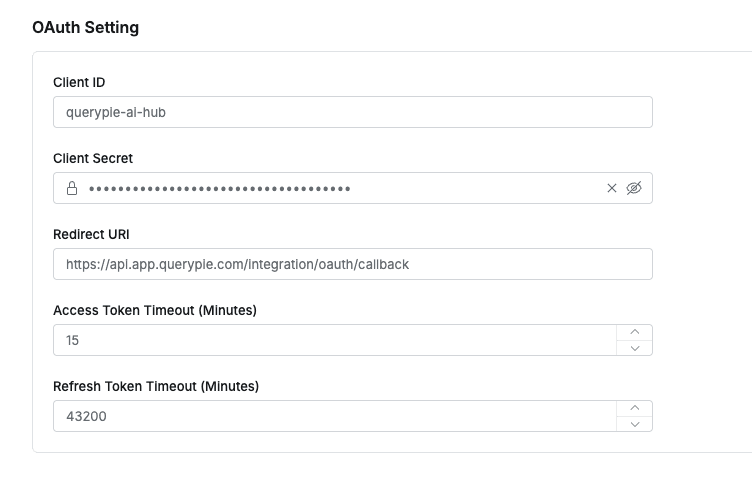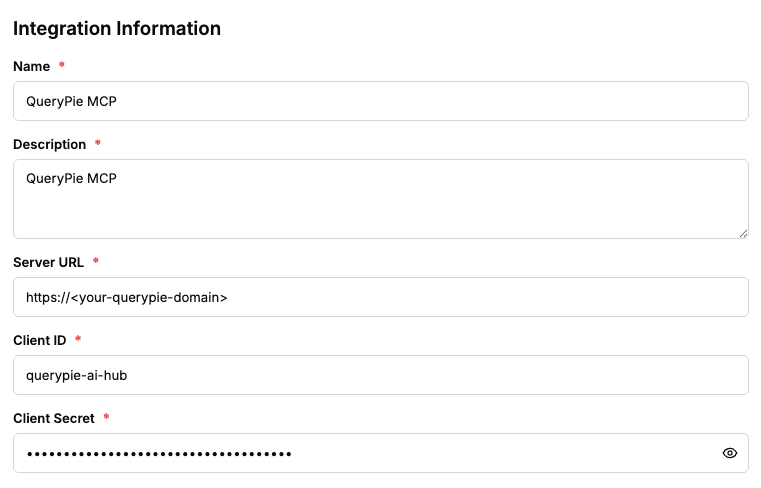QueryPie SAC - Admin
Manage server connections, permissions, and policies through QueryPie platform’s SAC (Server Access Control) administrator features.
Key Features
- Server group and server management
- Server permission management
- Server tag management
- Server account and credential management
- SSH key management
- Server access permission granting and management
- Server access policy and rule management
Basic Information
Authentication Method
Administrators must set up MCP server configuration in advance. Users authenticate using OAuth.
Input Parameters
- Server URL (Required): QueryPie domain
- Authorization URL for OAuth (Required): OAuth authorization URL
- Token URL for OAuth (Required): OAuth token URL
- Client ID (Required): OAuth client ID
- Client Secret (Required): OAuth client secret
You can find these in QueryPie admin page > General Settings > Security > OAuth Settings.
OAuth Integration Guide
This is the procedure to integrate QueryPie with AIP using OAuth. Please follow the steps below.
-
Access QueryPie and Admin Login
Access your organization’s QueryPie domain (e.g.,https://<your-querypie-domain>) and log in with an administrator account. -
Navigate to OAuth Settings
Go to Admin Page → General Settings → Security → OAuth Settings menu.
-
Copy Client ID and Secret
Enter Client ID and Copy your Client ID and Client Secret. You will need them in step 5 below. -
Enter AIP’s OAuth callback URL
Enterhttps://api.app.querypie.com/integration/oauth/callbackin the Redirect URI field. -
Access AIP and Enter OAuth settings in AIP
Enter the following values in the QueryPie MCP settings in the MCP Integration Management menu of the AIP administrator page:- Server URL: e.g.,
https://<your-querypie-domain> - Client ID (The value you copied in step 3 above)
- Client Secret (The value you copied in step 3 above)

- Server URL: e.g.,
Supported MCP Tools
Server Management Tools
manage_server
Manage servers and their configurations.
manage_server_group
Create and manage server groups.
manage_server_group_membership
Add or remove servers from groups.
manage_server_group_owners
Manage server group owners and permissions.
manage_server_group_filter_tags
Configure server group filtering tags.
manage_server_tags
Add or remove tags from servers.
Account and Authentication Management Tools
manage_server_group_account
Manage server group accounts and credentials.
manage_ssh_keys
Manage SSH keys for server access.
Access Permission Management Tools
manage_server_access
Grant or revoke server access permissions.
manage_roles
Create and manage server access roles.
Policy Management Tools
manage_policies
Manage server access policies and rules.
manage_command_templates
View and manage command templates.
Usage Examples
For example,
-
When you prompt “Show me the list of servers registered in the system”,
The LLM calls themanage_servertool through MCP to retrieve a list of all servers currently registered in the system. -
When you prompt “Add a new server to the dev server group”,
The LLM calls themanage_server_group_membershiptool through MCP to add a new server to thedevserver group.
Precautions
- Keep OAuth client information secure.
- Since this requires administrator privileges, ensure proper permission settings are configured.
- Follow your organization’s security policies when changing server connections and permissions.
- Regularly review access logs and policy application status.
- Securely manage SSH keys and server account information for security purposes.
- Review the impact on running services before changing server access permissions.